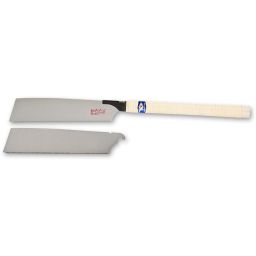I've been using Japanese saws for a good few years now, and one of the advantages over "normal" hand saws is that pulling is easier than pushing - and you can use two hands and get extra help from your upper body. Another advantage is that getting a straight cut is guaranteed, as long as you start off correctly.
I have in the past, cut through sleepers and other thick timber with relative ease using a Ryoba pattern saw, and that's ease of cut and not being tiring either. An fast too, so you won't need to take three weeks.
The only thing to be aware of, and few of the online "experts" tell you, is that the saw teeth size is matched to the saw length. So for first fix, or rough sawing, you'll need at least a 300mm blade to get suitably aggressive teeth.
I would suggest that such a saw would be more useful for future use than paying out for one of the power saws mentioned and then looking for uses for it.
And for clarity, I'm referring to proper Japanese saws, not western "pull saws" or £9.99 specials from Lidl and made in China.
I do have a Japanese cross cut blade purchased from Axminster Power Tools years ago.

Z-Saw Japanese Hassunme Crosscut Saw & Rip Saw Blade - PACKAGE DEAL
Package deal comprises Z-Saw Japanese Hassunme Crosscut Saw and the Z-Saw Rip Saw Blade. Z-Saw Japanese Hassunme Crosscut Saw The tooth form of this crosscut saw leaves the most incredible finish on end grain, almost like a planed surface. Featuring a...
I might give it a try and see how it goes.
I too am particularly fond of Japanese saws.
I once made the mistake of purchasing a Silverline pull saw-I was on site and it was the only pull store in the local hardware store. I had to cut through some tongues in a hardwood floor. The teeth started snapping off after about 5 mins.

